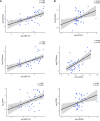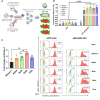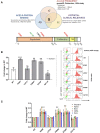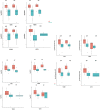GDF15 and ACE2 stratify COVID-19 patients according to severity while ACE2 mutations increase infection susceptibility
- PMID: 35937703
- PMCID: PMC9355674
- DOI: 10.3389/fcimb.2022.942951
GDF15 and ACE2 stratify COVID-19 patients according to severity while ACE2 mutations increase infection susceptibility
Abstract
Coronavirus disease 19 (COVID-19) is a persistent global pandemic with a very heterogeneous disease presentation ranging from a mild disease to dismal prognosis. Early detection of sensitivity and severity of COVID-19 is essential for the development of new treatments. In the present study, we measured the levels of circulating growth differentiation factor 15 (GDF15) and angiotensin-converting enzyme 2 (ACE2) in plasma of severity-stratified COVID-19 patients and uninfected control patients and characterized the in vitro effects and cohort frequency of ACE2 SNPs. Our results show that while circulating GDF15 and ACE2 stratify COVID-19 patients according to disease severity, ACE2 missense SNPs constitute a risk factor linked to infection susceptibility.
Keywords: ACE2; COVID-19; GDF5; inflammation; mutations.
Copyright © 2022 Torrens-Mas, Perelló-Reus, Trias-Ferrer, Ibargüen-González, Crespí, Galmes-Panades, Navas-Enamorado, Sanchez-Polo, Piérola-Lopetegui, Masmiquel, Crespi, Barcelo and Gonzalez-Freire.
Conflict of interest statement
The authors declare that the research was conducted in the absence of any commercial or financial relationships that could be construed as a potential conflict of interest.
Figures













Similar articles
-
Polymorphisms in ACE, ACE2, AGTR1 genes and severity of COVID-19 disease.PLoS One. 2022 Feb 4;17(2):e0263140. doi: 10.1371/journal.pone.0263140. eCollection 2022. PLoS One. 2022. PMID: 35120165 Free PMC article.
-
Polymorphisms of ACE (I/D) and ACE2 receptor gene (Rs2106809, Rs2285666) are not related to the clinical course of COVID-19: A case study.J Med Virol. 2021 Oct;93(10):5947-5952. doi: 10.1002/jmv.27160. Epub 2021 Jul 10. J Med Virol. 2021. PMID: 34170561 Free PMC article.
-
SNPs of ACE1 (rs4343) and ACE2 (rs2285666) genes are linked to SARS-CoV-2 infection but not with the severity of disease.Virol J. 2022 Mar 19;19(1):48. doi: 10.1186/s12985-022-01782-6. Virol J. 2022. PMID: 35305693 Free PMC article.
-
Single Nucleotide Variants (SNVs) of Angiotensin-Converting Enzymes (ACE1 and ACE2): A Plausible Explanation for the Global Variation in COVID-19 Prevalence.J Renin Angiotensin Aldosterone Syst. 2023 Apr 3;2023:9668008. doi: 10.1155/2023/9668008. eCollection 2023. J Renin Angiotensin Aldosterone Syst. 2023. PMID: 37051471 Free PMC article. Review.
-
Polymorphisms and mutations of ACE2 and TMPRSS2 genes are associated with COVID-19: a systematic review.Eur J Med Res. 2022 Feb 22;27(1):26. doi: 10.1186/s40001-022-00647-6. Eur J Med Res. 2022. PMID: 35193695 Free PMC article.
Cited by
-
GDF-15 Levels and Other Laboratory Findings as Predictors of COVID-19 Severity and Mortality: A Pilot Study.Biomedicines. 2024 Mar 29;12(4):757. doi: 10.3390/biomedicines12040757. Biomedicines. 2024. PMID: 38672113 Free PMC article.
-
Proteomics validate circulating GDF-15 as an independent biomarker for COVID-19 severity.Front Immunol. 2024 Apr 15;15:1377126. doi: 10.3389/fimmu.2024.1377126. eCollection 2024. Front Immunol. 2024. PMID: 38686386 Free PMC article.
-
Host factor PLAC8 is required for pancreas infection by SARS-CoV-2.Commun Med (Lond). 2025 Feb 3;5(1):34. doi: 10.1038/s43856-025-00745-6. Commun Med (Lond). 2025. PMID: 39900678 Free PMC article.
-
GDF-15 as a proxy for epigenetic aging: associations with biological age markers, and physical function.Biogerontology. 2024 Dec 7;26(1):22. doi: 10.1007/s10522-024-10165-z. Biogerontology. 2024. PMID: 39644331 Free PMC article.
References
-
- Albini A., Calabrone L., Carlini V., Benedetto N., Lombardo M., Bruno A., et al. . (2021). Preliminary evidence for IL-10-Induced ACE2 mRNA expression in lung-derived and endothelial cells: implications for SARS-Cov-2 ARDS pathogenesis. Front. Immunol. 12, 718136. doi: 10.3389/fimmu.2021.718136 - DOI - PMC - PubMed
MeSH terms
Substances
LinkOut - more resources
Full Text Sources
Medical
Research Materials

